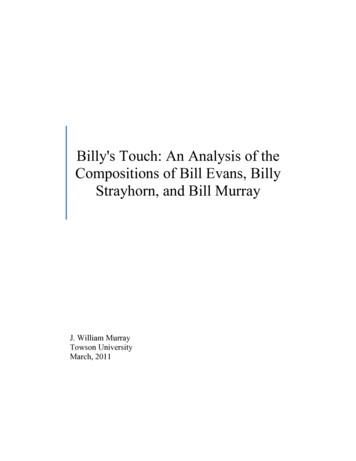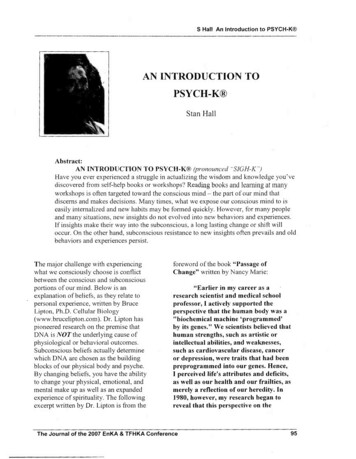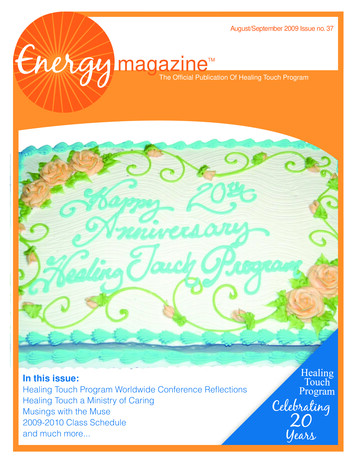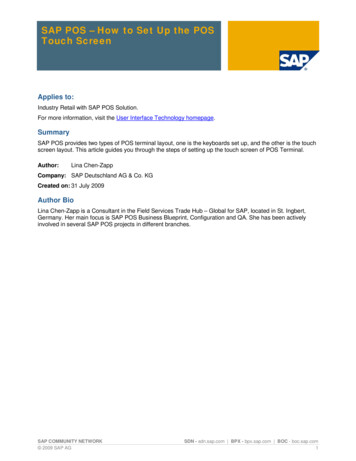
Transcription
Billy's Touch: An Analysis of theCompositions of Bill Evans, BillyStrayhorn, and Bill MurrayJ. William MurrayTowson UniversityMarch, 2011
Billy's TouchIntroductionComposers of any musical style are influenced by what they hear. There are certainsounds that resonate with each composer and musical elements that create these sounds willappear in his/her works. In addition to being influenced through the listening process, musicalelements of others composers are learned by analyzing their works, transcribing compositions orother means of study and will also likely find their way into compositions. The study of musictheory will also influence what appears in whatever they write or arrange.Because of all these influences and many more things that impact a particularcomposition, it is difficult to determine a specific influencer for most composers. However,most times when they are asked whose works they admire, they are able to name severalcomposers that are more meaningful. In my case, there are two composers, Bill Evans (19291980) and Billy Strayhorn (1915-1967), whose compositions have a particular resonance withme. Why am I drawn to these composers? Why do I enjoy listening to their works? Why do Ienjoy playing their tunes on the piano? These are all questions that I have been unable toanswer other than I enjoy listening to them.As part of my interest in and study of jazz, I have begun to compose tunes to be playedprimarily by small jazz ensembles. If the above hypothesis is true, characteristics of Evans's andStrayhorn's music should appear in my compositions. Other than listening to their compositionsplayed by groups or individuals, and playing some of them on the piano, no formal study of theirworks has been undertaken nor has extensive transcription of their works been done prior towriting this paper. Consequently, any musical elements contained in my compositions come2
from absorbing a certain sound that is common in their tunes and composing pieces that mayincorporate these elements without realizing it. The process of osmosis is at work as there hasnot been any conscious attempt to emulate either of them.This paper's purpose is to analyze whether any musical characteristics of thecompositions of Evans and Strayhorn appear in the compositions of Bill Murray. A series ofmusical characteristics that appear in select compositions of Evans and Strayhorn will bedeveloped. Only the lead sheets of the compositions will be analyzed. The compositionsanalyzed will be ones that appear in legally published fake books. Tunes in these books are partof the jazz repertoire and consequently ones that I have heard over the years. Fake books arealso the source for playing their compositions on the piano. The sound of these tunes is what hasresonated with me. Once musical elements have been identified, compositions of mine will beanalyzed to see if I have used any of them on a regular basis. Compositions of mine that are partof the analysis are contained in Appendix 1. The lead sheets for these tunes are contained inAppendix 3. The majority of them have been completed over the past several years while astudent at Towson University.Evans, though not a prolific composer, has some 50 pieces to his credit. One of the alltime jazz legends, he was more known for his piano playing than for his compositions. Hisplaying style is one that has influenced many jazz pianists and certainly has had an impact on thesound that I like. Even though it has no doubt had an impact on my compositions, Evans playingstyle will not be considered as part of the analysis. No analysis of transcriptions of his playingwill be undertaken. Appendix 1 also lists the Evans compositions used to develop the musicalcharacteristics used for the comparison.3
On the other hand, Strayhorn is credited with writing with hundreds of compositions.Most resulted from his association with the Duke Ellington Orchestra. Because of the closecollaboration with Ellington, it is sometimes difficult to determine who actually wrote a piece.Numerous times both are given credit for the tune. The Strayhorn tunes used for analysis arethose that are known to have been written by him even though dual credit may have been givenfrom a copyright perspective. Several of them were written by Strayhorn before he joined theEllington organization. A list of the tunes analyzed is contained in Appendix 1.To say that Evans and Strayhorn are the only influences on my compositions would be agross misstatement. However, this paper will only deal with characteristics developed from ananalysis of their compositions. In order to develop the characteristics used in the comparison, inaddition to analyzing the selected compositions, a review of each of their backgrounds isnecessary.Bill Evans's BackgroundRegarded as one of the most influential jazz pianists of all time, Bill Evans changed theway jazz piano is played and in the process influenced many of the best jazz pianists of the dayincluding Herbie Hancock, Chick Corea, Keith Jarrett, Hampton Hawes, Steve Kuhn, AlanBroadbent, Denny Zeitlin, Paul Bley, Michel Petrucciani, and countless others. Gene Lees,noted jazz author, called him the most influential pianist of his generation, changing theapproach to tone and harmony.1 James Lincoln Collier, another prominent jazz writer, says thatEvans had the widest influence of any piano player since 1960.2 Evans rewrote “the language ofmodern jazz piano, incorporating harmonic devices derived from the music of French1Leonard Feather and Ira Gilter, The Biographical Encyclopedia of Jazz (New York: Oxford University Press,1999) p. 214.2James Lincoln Collier, The Making of Jazz: A Comprehensive History (New York: Dell Publishing, 1978), p. 393.4
impressionists and forging an ensemble style noted for its complex yet fluid rhythmicinterplay.”3When Evans comes up in a jazz related discussion, two things are immediately discussed:his lyrical playing style and his harmonic approach to music. His tone was different and uniqueat the time when bebop was the reigning jazz style. Even today, Evans is used as a comparisonby reviewers of modern day jazz piano recordings. One will regularly read the comment that thepiano player being reviewed has been influenced by Bill Evans. Several of his trios arerecognized as among the greatest jazz piano trios. He and the members of his trios changed thenature and playing style for piano trios where the members became a collective rather than justperforming the traditional roles of piano, bass, and drums. These roles are common in today’spiano trios, but they were very inventive and new at the time Evans began using them.In addition to being a great pianist, Evans was also a composer. While books, doctorialtheses, and numerous articles have been written about Evans and his playing and improvisingstyle, there has been little focus on his compositions and his composing style.The purpose of a jazz composition is to set the stage for the improvisation that will followthe playing of the head. Jazz is about improvisation and not just about the composition orwritten notes. Evans wrote his tunes as a precursor to improvisation, but at the same time hefirmly believed that the improvisation was highly dependent on whether or not the original formhad something to say.4 As Harold Danko, a jazz artist, composer, and educator says,Nowhere can we learn more about the musical language of Bill Evans than from hisown compositions. . . we can gain insight into how he arrived at the musical contentthrough the process of composing. . . over the years, he used his own pieces as learning3Terry Teachout, “Does Bill Evans Swing?,” Commentary January, 1998: p. 46.Bill Evans and Harry Evans: The Universal Mind of Bill Evans: Jazz Pianist on the Creative Process and SelfTeaching, Dir. Louis Carvell, DVD. Eforfilms, 2004.45
vehicles for improvising, and the present generation can follow his trail by investigatinghis very important compositional output.5Influences on Bill Evans.Compositions are influenced by a person’s background and everything with which anindividual comes into contact. This was certainly the case with Bill Evans. Born in Plainfield,New Jersey in 1929, Bill Evans began to study the piano at age six. Later on he also studied theviolin and flute, but it was always the piano that interested him the most.6 Around five, Evanswould listen to his older brother Harry’s piano lessons and then play precisely everythingcovered in the lessons.7 This led to Evans taking his own piano lessons and practicing as muchas three hours each day.Around seven, Evans also began to play the violin. While this was not his favoriteinstrument, from playing it, he may have learned how to make the piano sing which became ahallmark of his style.8 In the liner notes to “Bill Evans: The Complete Riverside Recordings,”Evans says; “Especially, I want my music to sing it must have that wonderful feeling ofsinging.”9 This is an important characteristic of my own compositions and possibly the biggestinfluence of Evans on me.From six to thirteen, Evans studied the classical piano repertoire but had no idea how themusic was constructed. He won medals for playing Mozart and Schubert, and he also developed5Pascal Wetzel, Bill Evans Fake Book-Second Edition (New York: Ludlow Publishing, 2003), Preface remarks byHarold Danko.6“Bill Evans,” Contemporary Musicians, Volume 17, Gale Research, 1996, reproduced in Biography ResourceCenter (Farmington Hills, Mich,: Gale, 2008), Site address: umd.edu/servlet/BioRC.7Peter Pettinger, Bill Evans: How My Heart Sings (New Haven: Yale University Press, 1998), 11.8Pettinger, Bill Evans, 11.9Martin Williams, Liner notes, “Homage to Bill Evans,” Bill Evans: The Complete Riverside Recordings(Berkeley, CA: Riverside Records, 1984).6
an appreciation for Delius, Debussy, Satie, Ravel, Grieg, Rachmaninoff, and Chopin.10 Duringthis time, he continued to develop his sight reading skills playing only the notes on the page.Somewhere around twelve he began to play in a high school rehearsal dance band with hisbrother and discovered the jazz idiom of substituting chords to change the harmony. His sightreading capabilities led to many playing opportunities around Plainfield. Even at this age, healso had a desire to know how the music was constructed and worked on his own to figure outthe harmonies of compositions.11After graduating from high school, Evans received a scholarship to study music atSoutheastern Louisiana College located fifty miles outside of New Orleans. Peter Pettinger,author of a Bill Evan’s biography, How My Heart Sings, says that this was very instrumental inthe development of Evans’s style. In the early 1940s bebop was developing in New York City.Because of age and other things, Evans was not exposed to this style. By going many milesaway from his home to study music, he was put in a place that allowed him to develop his ownstyle and not be overly influenced by what was happening with bebop.12At Southeastern, Evans studied the classical piano repertoire. He played the sonatas ofMozart and Beethoven along with works by Schumann, Rachmaninoff, Debussy, Ravel,Gershwin, Villa-Lobos, Khachaturian, and Milhaud.13 Other composers studied included JohannSebastian Bach, Chopin, Stravinsky, and Scriabin.1410Keith Shadwick, Bill Evans: Everything Happens to Me-a musical biography (San Francisco: Backbeat Books,2002), 50.11Pettinger, Bill Evans, 12-13.12Pettinger, Bill Evans, 13.13Pettinger, Bill Evans, 16.14“Bill Evans,” Biography Resource Center.7
The program for his senior recital follows:15His study of classical composers was broad and diverse. He developed tremendoustechnique which he would use in later life, but it was always about the music not about using histechnique to be flashy. For example, he said that playing Bach helped him to gain control overthe tone that he would become famous for and to improve his contact with the keyboard.16Evans was very adept at drawing Western European compositional techniques into jazz and thereare elements of Bach, Chopin, Debussy, and Ravel in his writing.17 He was able to take theharmonic connections from Debussy, Satie, and Ravel through Scriabin to Bartók and Milhaudand apply them to jazz. He learned from Debussy and Ravel the ambiguities of tonality, from15Ron Nethercutt, “The Early Years,” Letters From Evans Vol. 1, No. 2 (Nov./Dec. 1989): 5.Len Lyons, The Great Jazz Pianists: Speaking of Their Lives and Music (New York: Quill, 1983), 226.17Andy LaVerne, “Bill Evans’ Twelve-Tone Tune,” Letter From Evans Vol. 2 No. 2 (Nov./Dec., 1990): 8.168
Bartók to employ wider chord intervals, and from Milhaud how to use bitonality.18 Thecompositional characteristics and techniques that he learned from studying the great classicalcomposers would become evident in his compositions and playing.The influence on Evans from classical composers can be readily seen in how he viewedthem. In 1966 Evans and his brother, Harry, prepared a documentary on the nature of music,jazz, and improvisation.19 He called jazz the revival of the classical music of the 18th and 19thcentury when improvisation was common by such masters as Bach, Mozart, and Chopin andlamented improvisations disappearance over the years as more attention has been place on thewritten music. He felt that these great composers liked the freedom of improvisation. Thisfeeling of freedom was one of the reasons that Evans moved toward jazz rather than becoming aclassical concert pianist, but the influence of the great classical masters never left him.At the same time Evans was studying the great classical composers at SoutheasternLouisiana, he was also continuing to play regularly in the New Orleans area with a collegiate triocalled the Casuals.20 He was playing and listening to a very different style of music than he wasstudying. After serving three years in the a
piano player being reviewed has been influenced by Bill Evans. Several of his trios are recognized as among the greatest jazz piano trios. He and the members of his trios changed the nature and playing style for piano trios where the members became a collective rather than just performing the traditional roles of piano, bass, and drums. These roles are common in today’s piano trios, but they .











